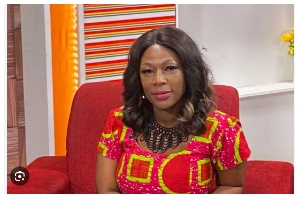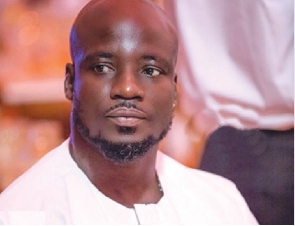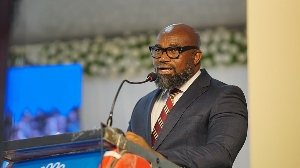Opinions of Wednesday, 4 June 2014
Columnist: Kwarteng, Francis
Maya Angelou: The Poetic Mistiness of Death
(1)
“Death,” they say, “is no respecter of persons.” Is this old bromide true? If it is, what has Death got to say about it, and, if not, what has Death still got to say about it? Yet, unlike Life, Death is probably, if pretextually, the most vocal, the most outspoken, ontological voicelessness in human socialization. It is not known if Death is integral to the structural mechanics of windiness, the mind, the spirit, or the soul. As well, Death is an immoral enigma. As well, Death is a moral certainty. Death is Life, a transient lie. Life is Death, the eternal truth. Alas, Death is the only human being that eloquently speaks a royal, imperial, or purple language for every human being to understand. Death is spiritually poetic. Death is materially musical. Death is culturally lyrical. Death is all that but!
What is Death? The Circle. Who is Death? The Straight-Line. On May 28, 2014, the same year Amiri Baraka, one of 20th-Century most gifted and prolific writers, passed on, Death bundled away Maya Angelou on the bared wings of poetic hydraulics. Then again, Death made a concrete presence when the world gave birth to Maya Angelou on April 4, 1928, in St. Louis, Missouri, USA, to Vivian Johnson and Bailey Johnson. Maya Angelou attended San Francisco’s Labor School (California Labor School), where Poetic Justice gracefully introduced her to another mystery of nature besides Death, the arts, particularly, drama and dance. The arts of living dramaturgy, of terpsichorean agility. A woman of graceful legginess, of vocal willpower to lift the human soul to emotional cloudiness, an experience akin to the enabling environ of sensualness, Maya Angelou.
What is Death? The Past. Who is Death? The Future. Death, a faceless mask, made a palpable presence in Maya Angelou’s home when Freeman, her mother’s boyfriend, raped her at age eight, as Oprah Winfrey was by close relatives. In the process, Oprah, the moral conscience of the American Nation, the gracious woman who fed eleemosynary institutions, lost a child to Angelou, a poetic wordsmith of global standing. Sad. The moral reciprocity of Life and Death. Unfortunate. How could Death have allowed such a depraved free-man to deflower the poetic vocality of public conscience, of a free-woman? Of Maya Angelou. A rhetorically bold woman of poetic truth.
What is Death? Alice Walker’s “The Color Purple.” Who is Death? Tsitsi Dangarembga’s “Nervous Condition.” Death, a faceless mask, made a tangible presence in Maya Angelou’s vocal cord when her filial abuse unraveled itself, bequeathing her a powerful gene of musical vocality, a priceless gift, which, in turn, gave her a poetic presence of global respectability. Maya Angelou, one of the world’s renowned auctorial pens of artistic ingenuity, of authorial creativity. Maya Angelou, the poignant authorial signature of “I Know Why the Caged Bird Sings,” “Gather Behind in My Name,” “Great Food, All Day Long,” “Mom & Me & Mom,” “All God’s Children Need Travelling Shoes,” “Celebrations: Rituals of Peace and Prayer,” “Phenomenal Woman,” “Still I Rise,” represented a fiery walking-tongue of the flowing definiteness of human consciousness.
What is Death? Mariama Bã’s “So long A Letter.” Who is Death? Ama Ata Aidoo’s “Anowa.” Maya Angelou, a dancing-poetic juggernaut of emotive presence authorially interpreted the world to the world, by herself, of herself, to herself, even, via a brilliant panoply of written works, of which “Amazing Peace: A Christmas Poem,” “A Song Flung Up to Heaven,” “Hallelujah: The Welcome Table,” “Singin’ and Swingin’ and Gettin’ Merry Like Christmas,” “My Friendly House, My Friendly Chicken, and Me,” and “Letter to My Daughter,” count among her corpus. Elizabeth Nyanibah. Maya Angelou. Oprah Winfrey. Winnie Mandela. Alberta Williams King. Mary Silvina. Rita Marley. Sarah Jane Richards. Nosekeni Fanny. Louis Norton…possessed the womb of creativity, of godliness. They gave the world what the world did not give man! Such great worldly unworldly women!
What is Death? Efua Dorkenoo’s “Cutting the rose (Female Genital Mutilation): The Practice & Its Prevention.” Who is Death? Waris Dirie’s “Desert Flower: The Extraordinary Journey of a Desert Nomad.” A dramatic-poetic beingness, that great woman, Maya Angelou, a blazing tutelage-conscience of authorial authority, of poetic prolificacy, and that other great woman, Oprah Winfrey, fought a Sisyphean battle from a long, nebulous distance, from far-off, as it were, in behalf of Africa’s trokosi girls, of Africa’s witch camp women, of Africa’s breast-ironing girls, of Africa’s Chibok girls, and even of Africa’s female genitally-mutilated angels. Wole Soyinka says of Nigeria, Boko Haram, terrorism, and the Chibok girls: “From a splurge of two hundred uses for the enforcement of human division to the abduction of two hundred female students into a forest fastness is one easy and predictable slide into the abyss. (See Soyinka’s “And Now, The Ecumenical City of Jos”).
Soyinka continues: “The same mentally. We could and should go further, but right now, the priority of the nation is to survive physically so as to be able to address questions of the mind. A National Dialogue that sits in session at this time must not avoid such rigorous, otherwise it has taken the side of the right of abduction?and enslavement?of one division of our humanity, and approved the right of arbitrary decimation of dissenting humanity in any form.” The women, two noble women, Oprah and Angelou, whose moral interiority drove away the social aloofness of male chauvinism, a deed much in the evocative likeness of JB Danquah’s awful, leprotic rejection of the people, the masses, according to Richard Wright, who paid Ghana a visit under the advisory aegis of George Padmore.
These women, Oprah and Angelou, capitalized on their intellectual resources and on the power of their public personalities to address those Soyinkan concerns, sensitive national issues previously mentioned. At the end of the day, it is the human brain, not Death, which is the ultimate arbiter of death and life. Hopefully, Maya Angelou, like all great minds, is not dead, supposedly, as Bob Marley reminds us in “Misty Morning”:
Misty morning, don’t see no sun;
I know you’re out there somewhere having fun;
There is one mystery…I just can’t express;
To give you more, to receive your less;
Don’t jump in the water, if you can’t swim;
The power of philosophy floats through my head; light like a feather, heavy as lead;
See no sun; Time has come, I want you;
I want you to straighten out my tomorrow;
Mysteries I just can’t express; How can you ever your more to receive your less?;
What “mysteries” is Bob Marley referring to? What is that “one mystery” Bob Marley is talking about? Is it the phenomenology of love, of death, or of what? Nevertheless, the great Bob Marley asks in advance: “How can you give your more to receive your less?” This open-ended question is for Maya Angelou in particular and lovers of humanity in general. We do know one thing for certain: Maya Angelou left us Bob Marley’s “One Love.” Then again, while Albert Einstein left us his “dead” brain imprisoned in a bottle of formaldehyde, Maya Angelou, on the other hand, left us her “living” mind in the social openness of conversational versatility.
Most importantly, let us look at the social utility of intellectualism, of which Maya Angelou’s immediately comes to mind, from another angle, courtesy of the late Prof. Edward Said, a onetime Harvard- and Princeton-educated Colombia University world authority on critical theory, colonial literature, English, post-structuralism, and comparative, a scholar greatly influenced by Kwame Nkrumah. He writes thus:
“The problem for the intellectual is not so much, as Carey discusses, mass society as a whole, but rather the insiders, experts, coteries, professionals who in the modes defined earlier this century by pundit Walter Lippmann mold public opinion, make it conformist, encourage a reliance on a superior little band of all-knowing men in power. Insiders promote special interests, but intellectuals should be the ones to question patriotic nationalism, corporate thinking, and a sense of class, racial or gender privilege (See Edward W. Said’s 1993 Reith Lectures “Representations of the Intellectual”).”
In effect, Said’s “intellectual” is the loose category of definition that subsumes the giant intellect of Maya Angelou. She gave her more and receives her less in Bob Marley’s moral estimation. That is, Maya Angelou’s strand of critical intellectualism was primarily one of self-criticism, of societal or community self-criticism, and the like. That is to say, Said’s understanding of intellectualism is nothing but service to the public, to the world, in exchange for improved human and race relations. This was why Maya Angelou, like Kwame Nkrumah, simultaneously, so to speak, was classified as being of the African world as well as of the Western world. Yet again, Maya Angelou, unlike the anti-people JB Danquah and KA Busia, loved the people. Prof. Said has written to that effect, an intellectual indictment descriptive of JB Danquah and KA Busia:
“According to Carey, British intellectuals like Gissing, Wells, and Wyndham Lewis detested the rise of modern mass societies, lamenting such thngs as ‘the common man,’ suburbia, middle-class taste; instead they promoted a natural aristocracy, ‘better’ earlier times, high-class culture (See John Carey’s “The Intellectuals and the Masses: Pride and Prejudice Among the Literary Intelligentsia 1880-1939”).”
Said again notes elsewhere: “For me the intellectual appeals (rather than excoriates) as wide as possible a public, who is his or her natural tendency.” Admittedly, Edward W. Said could not have stated it better! Granted, Maya Angelou, we believe, would have cautiously, if ungrudgingly, agreed with Said’s sentiments without so much as offering a rebuttal. The public offered her the requisite social space where she operated with intellectual finesse, emotive sociality, and spiritual humility.
Moreover, the tonic source of her relational presence in human consciousness was the expressive power of the “word,” which the website of PopChassid is kind to share with us in “What Maya Angelou Taught Me About Language”: “Most of the show I hadn’t paid so much attention to, but now I’m rapt. And I see that Chappelle is also. The man can’t say anything. Maya Angelou knows the power of the word more than anyone in the world, possibly. Do you want to know why I’m religious? It’s because of moments like this that I experience before I was religious. Long before I learned that The Hebrew word for “word” is the same as the word for ‘thing.’…”
The website continues: “In a documentary, Bob Marley’s wife, Rita Marley, said that Marley used his words like a gun. She used her hands to make the shape of a gun and indicate how every lyric he composed was a bullet aimed at the injustice of the world. The man was aware of the power of his words and his music, and this guy from this little country, from this little group of unknown religious zealots called Rastafarians, changed the world. That is the power we have when listen to Maya Angelou. When we realize that words are real, the words are things. This isn’t just funny, mystical talk. It’s a reality.”
Thus, the tongue can make and unmake, break and un-break; the tongue can be an individual’s or the worlds doing or undoing. Maya Angelou knew this and thus used her powerful tongue to bring the world together.
We shall return…












